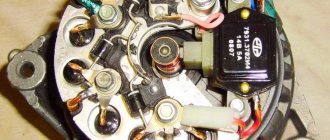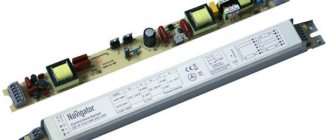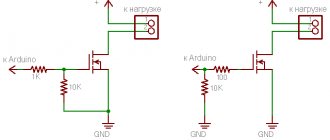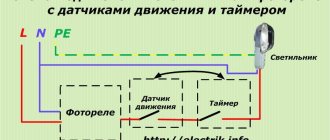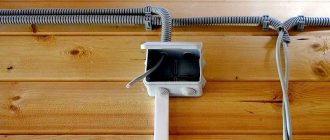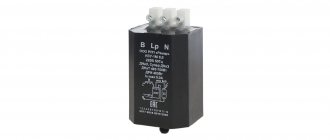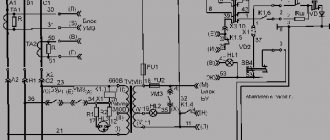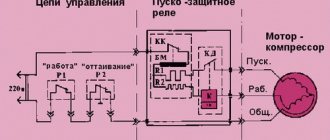The reversing switch is a manual switch. It is necessary to switch the power supply to the house's electrical wiring from the city line to the generator.
In contrast to the automatic switching on of the reserve - ATS, with the help of a reversible (changeover) switch, the reserve is manually switched on. That is, if there is no voltage in the city line, you must manually start the generator and switch it; when voltage appears in the city line, you must manually switch to the city line and turn off the generator.
The peculiarity of changeover switches is that switching occurs with an open circuit; they have three positions: I – 0 – II, or: city line – 0 – generator.
Today, to manually switch on the reserve of a private home, reversible (changeover, modular) switches from ABB are almost always used.
For electrical installation in private homes, two types are sufficient: ABB OT63F3C and ABB OT40F3C, respectively for 63A and 40A.
As an example, a connection diagram is shown for a three-phase house wiring diagram and a single-phase generator.
These devices are produced for three-phase networks, but they can also be used in single-phase electrical wiring circuits without any problems.
The ABB reversing switch is modular, it is a compact, modern and reliable device. Installation is possible in any panel on a DIN rail.
In dacha areas, garden plots, the private sector and similar places, frequent power outages are common. Here they can turn off the lights for an hour, for the whole day or for a longer time. This creates quite a few problems, since people can no longer imagine life without electricity. He has things working at home: a refrigerator, a TV, room lighting, a pump for watering the garden, and the like.
Gasoline power plants are very popular in such places. Turn off the lights, start the gas generator and continue to enjoy life. The power plant must be connected to the distribution board through a special outlet. Below I look at the diagram of a distribution board with a “mains-generator” switch, which allows you to switch to power supply from a gas generator when the external network is lost and back.
Here I am considering manual switching, which is carried out using a reversing switch. All diagrams show an ABB OT40F3C switch. This is a high-quality and reliable reversible switch. It has three positions:
- the handle is turned to the left - the contacts on its left side are closed, and on the right side they are open;
- the handle is in a vertical position - all contacts are open (both right and left);
- the handle is turned to the right - the contacts on its right side are closed, and on the left side they are open.
If what is written is not entirely clear, then look at the latest diagram and you will immediately understand how it works.
It is worth noting that if you take such a reversing switch for a higher current, then the switch handle is not included in the kit. It must be purchased separately.
Below is a simple single-phase switchboard diagram with a mains-generator switch. This is plenty for a small dacha or garden house. If you have a large house, then you need to revise the ratings of the input machine and increase the number of group lines. Everything is individual here.
It is very convenient to use a network indicator in such panels. For example, the signal lamp LS-47. Why is she needed here? Let's say the lights are turned off and you start the power plant. Everything is working.
Next, how to determine whether there is voltage in the network or not? You won’t run to the switchboard every half hour and use an indicator to check whether the light is on or not. This is not convenient and is forgotten over time. So you can miss this moment and “sit” on the gas generator until the evening. And gasoline is expensive these days.
In such a situation, the mains voltage indicator will immediately show you when the light will come on. It will just light up and you will immediately notice it. It is clearly visible from afar even through the transparent cover of the shield. As soon as the warning light came on, they immediately turned off the power plant and switched the switch to mains mode.
Below is the same diagram of the distribution board, but with an LS-47 signal lamp.
If you want to protect yourself and your dacha from current leaks, then you need to install an RCD. Below is a diagram with one common protective device. If you want more, then go ahead and fight. Here you can fantasize endlessly.
For a better understanding of the operation of such a circuit, I schematically showed the state of the contacts of the reversing switch with red lines and the direction of the current with red arrows.
Below is the work from an external network.
And here the work from a gas generator is already presented.
And these are already two diagrams of the operation of this switchboard in one. It looks like a cartoon. Like?
At the request of site visitors, I am posting below a 3-phase electrical panel diagram with a “network-generator” switch
Basic mistakes
There are a number of mistakes that inexperienced electricians make.
You cannot connect a mini-power station to a home outlet when the machines in the input panel are turned off. During rare power outages, it becomes a tradition to “throw” the gas generator cable to the nearest connector through a plug. Most people argue: why install a backup input if the power goes out 2-3 times a year. Russian people live by the principle: a man does not cross himself until thunder strikes. Electricians do not recommend even thinking about connecting a generator through an outlet for the following reasons:
- There is no separate machine in the line.
- The socket group is not capable of accepting the main load.
- The human factor comes into play: the owners forget to turn off the input circuit breaker, which leads to overloads and tripping of the protection.
- There is a possibility of an “oncoming collision”: electricity begins to flow from the public network while the generator is running. The unit fails.
- Do not neglect the comfortable and reliable operating system of the unit. It is better to study the diagrams for connecting the generator to the home network and choose the best option. This will save equipment and the electrical network.
The generator must have a power several times less than the wiring capacity. For example, the value for an outlet is 3.5 kW. Otherwise, overheating, short circuit and fire will occur. When the machine is turned on, the power will be restored, and the backup source will break down.
However, in some cases, connecting the generator through an outlet is possible. If the mini-station matches the power, then it can be connected to the distribution panel to the switch contacts, but from the generator side. The best option would be to connect an extension cord to it first, and only then the necessary devices. This will prevent the backup source from connecting to your home network.
At the dacha and in a country house, in case of constant outages of the main source, the reserve is connected through a changeover switch, an automatic start system or a reversing switch.
Recommendations: how to connect a gas generator to the network at home
If you want to connect a gas generator to the network of a country house, you can do it yourself, but this is quite a responsible and difficult job. Therefore, if you have doubts about your abilities, it is better to entrust such a matter to professionals.
First you need to choose the right room to locate the unit. This place should be well ventilated and soundproofed. You also need to take into account all safety regulations, especially if gasoline or diesel is used as fuel. Next, you need to run the wires connecting the house panel and the generator itself.
To connect a gasoline generator to a diesel power plant, you cannot do without a transfer switch. The use of such a unit will greatly facilitate the use of the generator:
- If there is voltage in the network, then the switch should be in position “1”;
- When the voltage disappears, you need to turn off all the machines one by one and move the switch from position “1” to “0”, and then to “2”;
- After these steps, you can safely start the generator.
To find out when electricity appeared again, you can look at the diode on the electric meter. If there is no light, the diode is off, but if there is, then it works.
When purchasing a generator, it is better to pay attention to an inverter device or one with a built-in AVR function, which will help protect equipment from breakdowns due to power surges. The device may not hold the 220V indicator, but a slight deviation in one direction or another with AVR (210-230V) is considered quite normal
Installation equipment
You don't need a lot of equipment to connect an electric generator to your home's power grid. It is enough to determine the location of the unit, ensure sound insulation and ventilation in accordance with the standards. Most likely, you will have to make a cement-sand screed in the room to reduce vibration.
It makes no sense to consider installing mobile generators up to 2 kW. They cannot fully provide the house with electricity. In addition, they are mobile and do not require special location conditions.
Let us describe the installation of an electric generator with a power of 2 kW or more. To organize a backup power supply network you will need:
- Copper cable with a cross section of 4 square meters. mm for organizing a separate input. The length must correspond to the distance between the input device and the location of the generating set.
- Modular changeover switch that can be fixed on a 35 mm DIN rail. Among inexpensive models, TDM-63 has proven itself well, while ABB and Hager are more reliable.
Attention should be paid to grounding, since the connection must comply with the PUE. In other words, before connecting the reserve, it is necessary to organize a TN-CS or TT grounding system.
Differential protection at the generator output will not be superfluous. Even with a two-wire type of wiring, no one has canceled the grounding of the generating device.
Change-over switch for generator
The switch for the generator must be a single-module modification, and the interlocking design must have a classic contact pattern. Speaking of the reversing unit, it is manufactured in a version with a controller. As a result, on devices equipped with a resonator, there is no need to set the selection.
In such situations, the threshold frequency value will be quite high. The switches used can be of different sizes - this largely depends on the number of feed-through capacitors used.
Before you start installing a switch, you need to carefully study how the grounding system works. It must contain a special grounding electrode with markings containing all the necessary information about protection.
Most often you can find products on sale labeled “IP30”. Such information suggests that the consumable has fairly reliable insulation.
Follow these tips if you want to use the changeover switch in your housing safely:
- The device can only be installed indoors.
- The device must be moisture-resistant and resistant to natural precipitation.
- The device can be operated at temperatures ranging from -40 to +55°C.
- If the top of the contact knife is burnt, you need to clean it with a file.
- The fastening of the switch must be reliable and durable.
Selection of electric generator
A home power plant consists of an internal combustion engine and a rotating generator that produces electricity. The most common are four-stroke models with a maximum speed of 3 thousand revolutions. The volume of the fuel tank in domestic models is 10-15 liters. The main selection criterion should be the area of use. Generators can act as the main source of energy, but more often they are a reserve in an emergency.
When choosing, you should pay attention to some parameters:
When connecting, it is important to ensure the coordinated operation of 3 elements:
- home network - consumer;
- centralized supply chain;
- cable from the reserve.
Before connecting, determine the following points:
- safe and economical location of the electric generator;
- frequency of power failures in the general network, need for automation;
- calculated power consumption taking into account reserve and losses.
A suitable connection diagram must be provided.
Automation of electrification requires a lot of financial investments and regular qualified maintenance. For an individual home, the gentlest mode would be manual connection. It makes sense to use partial automation in the form of semi-automatic machines - their cost is not high. However, with any choice, the system must be periodically monitored.
A continuous supply of energy is quite expensive; a private home rarely needs such provision. Important consumers of electricity, such as a computer, can be connected to an uninterruptible power supply.
Definition and purpose of a reversing switch
A reversing switch is a special switch, thanks to which the master can switch to the opposite state (invert) the switching of conductors connected to the device.
The device is used in three-phase current circuits. When installing a switch, it is possible to evenly redistribute power across several lines without disrupting the power supply to the entire house or room.
The reversing switch is installed at the following facilities:
- Private houses if they have powerful equipment: oven, hob, etc.
- Industrial enterprises in the food sector: bakeries, bakeries, confectionery factories, food production plants.
- Heavy industry.
- Medical institutions.
- Public institutions: cinemas, shopping centers, museums, etc.
Switches are used wherever there is a need for a complete organization of switching without failures. It is important here to eliminate the possibility of a short circuit.
Types of generators
Household energy sources can be different types of generators, but the most popular are gasoline ones. They have the following features:
- wide range of prices;
- power 0.8-12 kW;
- small sizes;
- there are stationary and mobile models;
- There are single-phase and three-phase;
- A four-stroke internal combustion engine is used.
When choosing a connection diagram, it is necessary to take into account the method of cooling the internal combustion engine, which in turn depends on the time and frequency of operation. Most often, models are equipped with air radiators. Industrial models are able to work for a long time, as they are equipped with liquid cooling. This increases overall dimensions, but increases efficiency.
Diesel generators are used less frequently in home networks, as their cost is higher. However, their use is justified by a large resource.
Types of electric generators
There are several types of electric generators:
- Asynchronous. They have a simple and reliable design. All components are completely protected from moisture and dust. The devices are best used for active loads. Asynchronous generators are not recommended for use to power an electric motor.
- Synchronous. They do not contain the listed disadvantages of asynchronous generators. They are also able to maintain voltage more accurately. Preference should be given to a brushless design with better current characteristics and less radio interference. Inventory models have lower power and higher cost. Single-phase ones have worse characteristics, especially inexpensive ones. Three-phase generators are a little better. The second disadvantage is the high cost and lower reliability.
Single-phase and three-phase
If there are no three-phase consumers in the house, then it is better to install a simpler model for rational use of power. Connecting a single-phase generator yourself is much easier. The cost of three-phase units is higher, and the generator itself must be evenly loaded across three loads evenly. Failure occurs when the difference exceeds 25%. As a backup source, a single-phase generator is preferable for any output.
Types of switches
Reversing relays are classified according to several criteria - the number of poles and current switching.
There are these types of switches:
- Single pole. Used for single-phase electrical networks. They have one module with a copper conductor. Most often used in residential areas. A single-phase reversing machine is ideal for generators with a frequency of no higher than 20 Hz.
- Bipolar. They are most often used in apartments with conventional and more powerful household appliances. The switch is equipped with two inputs. This means that with its help you can simultaneously power equipment from a three-phase and single-phase network. The negative resistance of such devices is 60 ohms. In this case, the input voltage is not regulated for bipolar devices.
In terms of rated currents, the manufacturer offers the modern consumer machines with switching parameters from 16 A to 1.6 kA. Some varieties can be used in networks with voltages up to 660 V. Some - with values up to 440 V.
Connection diagram
There are several ways to use an additional power source:
- Connection via a separate reserve circuit to a dedicated group.
- Using a three-position switch or changeover switch. To power the entire circuit, jumpers are made on the generator side at the input. The only negative is that three-phase consumers do not work.
- Installation of two contacts for power supply from a backup source and the city network. The method is used for AVR. Jumpers must be made on the reserve side.
A three-phase generator is connected to a three-phase network in the presence of an electrical receiver. An example would be the electric motor of machine tools.
Generator autostart
A full-fledged load switching method involves the use of an automatic transfer switch. The system has an electric starter. The autostart device begins to control the external network after power is applied to it. Before connecting the generator, the automation waits about 10 seconds after the voltage disappears. Next, the external network is completely isolated and the diesel generator is started. It takes about 20 seconds to reach full speed, after which a connection to the home network is established. After the external network is restored, the backup is turned off, and the home network begins to operate as usual. Only after this the generator engine is turned off.
The diagram assumes that the generator has an engine stopping system and a starter. If you have a lot of experience, you can organize it yourself, but it is troublesome. The issue can be resolved in two ways:
- Purchase a complete control unit with the electric generator. It is connected according to the diagram specified in the instructions. It will not only regulate starting and stopping, but also the speed, that is, the final power.
- ATS devices that have components installed on the generator as additional equipment to control the throttle valve and starter.
The kits have current protection and insure against overvoltage and leaks. Installation consists of connecting consumer wires and input to switching devices.
Using a generator with an ATS is an expensive but convenient solution.
Installation and connection rules
Changeover switches are installed inside distribution boards - ASU. For modular devices, standard DIN rails are provided. The dimensions of the shield are selected according to the number of installed modules. Switches in the usual design are mounted on specially designated mounting panels. A DIN rail can also be used here to accommodate modular protective equipment.
Shields made of plastic or metal are used indoors, and only metal products with the required degree of protection are installed outside.
The main cable supplied from the metering board is connected to one of the inputs of the switching device. The other input is for the backup cable connected to the generator. If the switch has only one output, a cable coming from the distribution panel is connected to it. Modular devices usually have 2 inputs and 2 outputs. The outputs are connected in parallel using jumpers, after which they are connected together to the distribution board.
Such a connection is clearly visible in the example of a single-phase network, to which a three-pole changeover switch is connected, connecting the generator to the electrical network. The main requirement for carrying out such a procedure is to maintain polarity. Correct connection will allow you to avoid changing the positions of phase and zero when making switchings. At the network input, protection is installed in the form of a circuit breaker located in the metering panel. The input coming from the generator is also protected by a machine installed in the panel along with the switch.
Connecting the device can additionally use automatic transfer of a reserve - ATS, or the reserve is switched on manually using an automatic machine. In the case of using changeover switches, such switching is performed without load. First, the load is switched off automatically, and only then all the necessary manipulations with the switch are carried out.
If the design of the switch includes an arc extinguishing device, then switching can be done directly, without first turning off the machine. However, the circuit on all lines must necessarily include fuses or circuit breakers, since the switch itself will not be able to protect the network in an emergency.
Operation of the changeover switch will be safe if you follow the installation rules and recommendations of specialists:
- For installation and further work it is better to use a closed room.
- Switching equipment is reliably protected from moisture and negative external environmental influences.
- The temperature limit at which normal operation is possible is from minus 40 to plus 55 degrees.
- Installation of the changeover switch and its fastening must be strong and reliable.
When installing the device outdoors, you should first ensure protection from external influences. At possible low temperatures beyond the permissible limits, a heating system for the cabinet should be provided in advance. All work on installation, maintenance and repair of switching equipment must be carried out by qualified specialists, with the network completely disconnected.
AVR system
Organizing an automatic launch costs significantly more than a manual one. However, it does not cancel external control - starting the internal combustion engine involves controlling the throttle valve. As previously noted, the engine must be warmed up after starting. Some owners use partial automation - the main power is connected through a contactor. When the input is disabled, it opens. The next step requires you to manually start the generator. It has a built-in relay for warming up and automatically switching the home network to a backup source. When electricity appears in the main network, the contactor is turned off, and the load goes to the general network. With full automation of power supply, the reserve has microprocessor regulation of the generator operation.
Generator connection
The generator must be well protected from moisture. For this purpose, use a separate room or canopy. When installed indoors, exhaust gas must be provided. The electric generator is installed after the meter, otherwise you will have to pay for the energy you generate yourself. A backup source can be used to top up during peak loads. It is necessary to choose the right installation scheme to avoid unnecessary expenses.
Unstable power supply leads to the problem of how to connect the generator to the home network. You should choose simple and safe schemes. A generator with an internal combustion engine will be a convenient source of energy. The equipment is easy to transport and use, its cost is not high. To correctly select the optimal circuit, you will need to know the features of the device and switching equipment.
Connection features
The choice of connection diagram for a changeover switch is influenced by the type of electrical network.
Single-phase network
You can connect such a device to this network only if it has two poles. In addition, you need to take into account that the operation of the switch is only possible if there is a power supply with suitable technical characteristics. As for jumpers that provide contact between two-pole devices, it is advisable to give preference to copper ones.
Before installing such switches in a residential building, it is necessary to check the availability of electrical panels KK202 or their analogues.
Two-phase network
How to connect a switch with your own hands if the network is two-phase? The circuit involves the use of a 200V power supply. Also, for these devices you need to use only expansion switches. Only then can the devices be used in a three-phase power supply network, regardless of the number of modules used.
The maximum voltage for such devices will be 300V, and the maximum negative resistance will be 40 Ohms. The contacts in such devices are applicable exclusively to closed models, and fluctuations in electrical energy are controlled using pass-type capacitors.
Three-phase network
For this type of electrical network, reversible switches are used. They provide a complete uninterrupted supply of electric current, distributing the load over several lines and completely preserving the power supply. Here you need to use 400 V power supplies. It would also be appropriate to use pulse transformers.
Photos of an ABB reversing switch, photos of a changeover, modular switch.
Due to possible discrepancies in performance characteristics, reversing units are not used for single-phase circuits. Video Modern electrical circuits are switched by various devices produced in a wide range.
First of all, it is installed in residential buildings. Such devices are called two-position devices. By means of reversible blocks, the required current frequency is supported.
And this is how distribution boards are mainly installed - they have a circuit breaker installed at each input.
A DIN rail can also be used here to accommodate modular protective equipment.
It is also important to remember that for this device it is necessary to use only expansion type switches. The dimensions of the shield are selected according to the number of installed modules. Circuit breakers - polarity and connection diagrams
More on the topic: Measuring loop resistance phase zero

